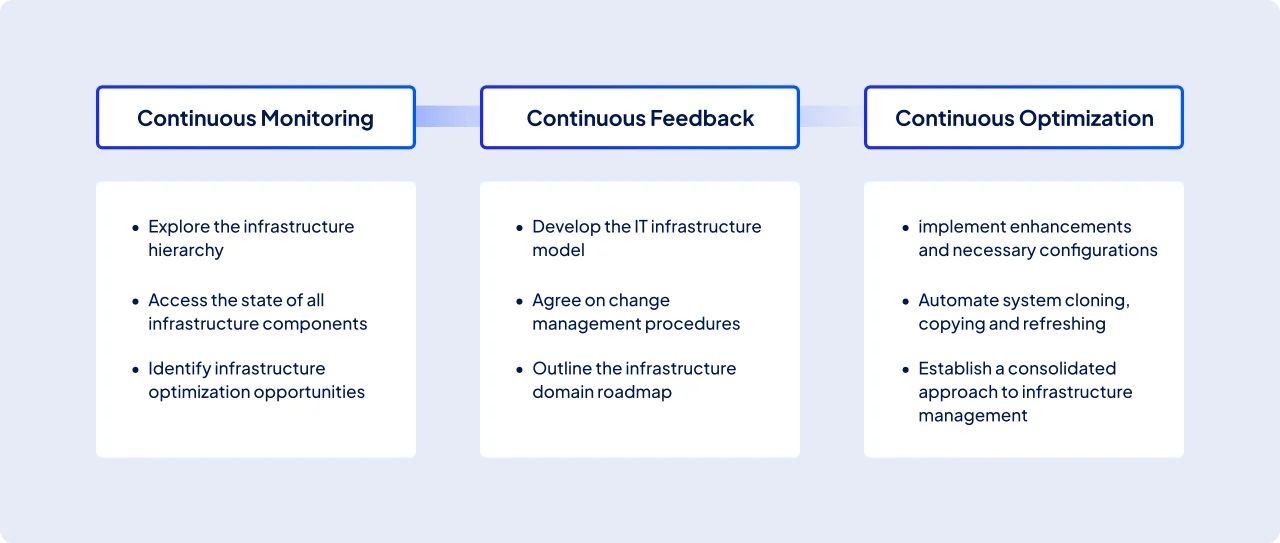IT services management
Streamline and Optimize Your IT Operations with advansappz
As a leading provider of IT services management, advansappz can help you streamline and optimize your IT operations. Our team of experts offers a range of services, including software administration and infrastructure administration, to help you improve the efficiency and effectiveness of your IT operations.

Aspects of our product development bundle

The Benefits of Choosing advansappz for IT Services Management
Streamline Your IT Operations and Achieve Greater Success with Our Expertise
Advisory Services for IT Operations
Our advisory services for IT operations are designed to help you achieve your goals and improve the efficiency and effectiveness of your IT operations. Our team of experts will work with you to identify the most critical issues and develop a comprehensive strategy for addressing those issues.
Prioritization of IT Operations
Our team will prioritize your IT operations to help you focus on the most critical issues and achieve greater success. We will work with you to identify the most pressing issues and develop a comprehensive strategy for addressing those issues.
QA & Backup
Our QA and backup services will help you ensure the reliability and stability of your IT operations. We will work with you to develop a comprehensive backup plan and implement solutions to help you protect your data and ensure the continuity of your IT operations.
Frequently Asked Questions
Do you have additional questions?
IT Service Management (ITSM) refers to the set of processes, policies, and activities designed to plan, deliver, manage, and support IT services within an organization. The role of IT Service Management is to ensure that IT services align with the needs and objectives of the business while delivering value to customers and stakeholders. Here are some key roles and responsibilities of IT Service Management:
Service Strategy: ITSM defines the strategic approach for delivering IT services. It involves understanding the business objectives, identifying service requirements, and aligning IT capabilities to support those objectives.
Service Design: ITSM encompasses the design of IT services, ensuring they are fit for purpose and meet the business requirements. This includes defining service levels, service catalogs, service portfolios, and service architectures.
Service Transition: ITSM manages the transition of IT services from development to production. It involves planning, testing, and implementing changes, releases, and deployments while minimizing disruption to the business.
Service Operation: ITSM ensures the effective and efficient operation of IT services. It involves managing incidents, requests, problems, and changes, as well as monitoring service performance and addressing service disruptions.
Continual Service Improvement: ITSM focuses on continuously improving IT services to enhance their quality and value. This includes analyzing performance metrics, gathering customer feedback, and implementing initiatives for service optimization and innovation.
IT Governance: ITSM plays a role in ensuring IT services comply with regulatory requirements, industry standards, and organizational policies. It involves establishing processes for risk management, security, compliance, and data protection.
Customer and User Relationship Management: ITSM emphasizes building and maintaining positive relationships with customers and users. It involves understanding their needs, managing expectations, and providing effective communication and support throughout the service lifecycle.
Service Level Management: ITSM is responsible for defining and managing service level agreements (SLAs) with customers. It includes setting performance targets, monitoring service levels, and reporting on service performance against agreed-upon metrics.
Vendor and Supplier Management: ITSM oversees relationships with vendors and suppliers to ensure the delivery of high-quality services and effective management of contracts and agreements.
Service Desk and Incident Management: ITSM includes the establishment and management of a service desk to handle customer inquiries, incidents, and service requests. It involves incident logging, classification, prioritization, and timely resolution.
An IT Service Management (ITSM) tool is a software application or platform that helps organizations automate and streamline their IT service management processes. It provides a centralized system for managing and delivering IT services, supporting various activities such as incident management, problem management, change management, service request management, and asset management. ITSM tools typically offer a range of features and functionalities to facilitate efficient IT service delivery and enhance customer satisfaction. Here are some common features of ITSM tools:
Incident Management: ITSM tools enable the logging, tracking, and resolution of IT incidents, ensuring timely response and restoration of services.
Problem Management: These tools facilitate the identification, analysis, and resolution of underlying causes of recurring incidents or problems, aiming to prevent future incidents.
Change Management: ITSM tools help manage and track changes to the IT environment, ensuring proper assessment, approval, and implementation of changes while minimizing risks.
Service Request Management: These tools support the management and fulfillment of service requests from users, providing a streamlined process for submitting, tracking, and fulfilling requests for IT services or resources.
Asset and Configuration Management: ITSM tools assist in managing IT assets and configurations, including hardware, software, licenses, and associated documentation, allowing organizations to track and control their IT inventory.
Yes, IT Service Management (ITSM) is a key component of the IT Infrastructure Library (ITIL). ITIL is a framework that provides best practices and guidelines for effective IT service management. It offers a set of detailed processes, functions, and roles that organizations can adopt to align their IT services with business needs and deliver value to customers.
ITIL defines a comprehensive set of ITSM processes, commonly referred to as ITIL processes. These processes cover various aspects of IT service management, including incident management, problem management, change management, service request management, and more. The ITIL framework emphasizes the importance of customer-centric service delivery, continuous improvement, and the adoption of a lifecycle approach for managing IT services.
Organizations that follow ITIL practices typically adopt and adapt the ITIL processes to suit their specific needs and organizational context. The goal is to improve service quality, optimize resource utilization, enhance operational efficiency, and ensure effective IT governance.
The three pillars of IT Service Management (ITSM) are people, processes, and technology. These pillars form the foundation for effective IT service management practices and are crucial for delivering high-quality IT services. Here’s an overview of each pillar:
People: The people pillar of ITSM focuses on the individuals involved in delivering and managing IT services. This includes IT professionals, service desk agents, IT managers, and other personnel responsible for IT service delivery.
Processes: The processes pillar of ITSM focuses on establishing structured and efficient processes to manage IT services throughout their lifecycle. Processes provide a systematic approach for delivering, supporting, and improving IT services. Key aspects of the processes pillar include:
Technology: The technology pillar of ITSM focuses on leveraging appropriate tools, systems, and technologies to support and enable effective service management. Key aspects of the technology pillar include:
Manage your IT infrastructure more efficiently with advansappz
Let Us Help You Streamline and Optimize Your IT Operations







